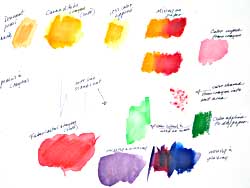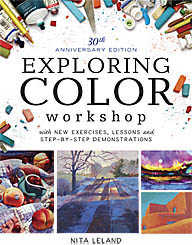Watercolor pencils and crayons
 Exploring watercolor pencils and crayons with my class on Monday was verrrry interesting. I've used them seldom, tending to be a washy kind of watercolor painter. Also, my past observations led me to believe that they were extremely limited. I remember early experiences as a kid with Mongol watercolor pencils--they never had enough color in them and always left streaks. Some years ago I bought a lovely set of Derwent pencils and found them disappointing. But for some reason, through the years I've acquired two sets of watercolor crayons (Caran d'Ache and Faber Castell) that I never opened until Monday. I was hoping to be pleasantly surprised after re-reading two books over the weekend, Gary Greene's Painting With Water-soluble Colored Pencils (North Light, 2002) and Cathy Johnson's Watercolor Pencil Magic. (North Light, 2002). Both have lots of demos and illustrations of techniques. Greene's techniques are more painterly; Johnson's appear more doable for sketching and travel.
Exploring watercolor pencils and crayons with my class on Monday was verrrry interesting. I've used them seldom, tending to be a washy kind of watercolor painter. Also, my past observations led me to believe that they were extremely limited. I remember early experiences as a kid with Mongol watercolor pencils--they never had enough color in them and always left streaks. Some years ago I bought a lovely set of Derwent pencils and found them disappointing. But for some reason, through the years I've acquired two sets of watercolor crayons (Caran d'Ache and Faber Castell) that I never opened until Monday. I was hoping to be pleasantly surprised after re-reading two books over the weekend, Gary Greene's Painting With Water-soluble Colored Pencils (North Light, 2002) and Cathy Johnson's Watercolor Pencil Magic. (North Light, 2002). Both have lots of demos and illustrations of techniques. Greene's techniques are more painterly; Johnson's appear more doable for sketching and travel. And I was amazed. It was apparent that the Derwent pencils are harder than the sticks, but that made it easy to make a clean line where needed. The range of techniques was surprising --wet-in-wet; wet-on-dry; dry-on-wet and much more. You can lift color from the stick and apply it to paper. You can apply color to a sheet of extra paper and use it as a palette, lifting color and painting with it. I even scraped shavings from a stick onto damp paper and got the look of spatter. And the colors are brilliant. I wonder if Mongol pencils have improved since I used them many years ago.
There are numberous sites on the Web that give detailed technical information on techniques. Here are two: Watercolor Pencil Class 2 and
What are Watercolor Pencils?. For more, Google "watercolor pencils."
Labels: tutorials, watercolor crayons, watercolor pencils





2 Comments:
Thanks for the link Nita! My initial encounter with watercolor pencils was also disappointing; it seemed impossible to get strong color and I didn't enjoy the hardness of the pencils. But newer watercolor pencils definitely seem to be a different creatures, with a greater range of hardnesses. Recently I've been enjoying using Lyra's "aqua crayons", without a wooden surround to the 'lead'. Though I did discover they get really soft if you leave them in direct sunlight!
The Lyra crayons sound like the Caran d'Ache and Faber Castell that I have. I'll remember not to leave them in the sun--and probably shouldn't leave them in a hot car, right?
Post a Comment
<< Home